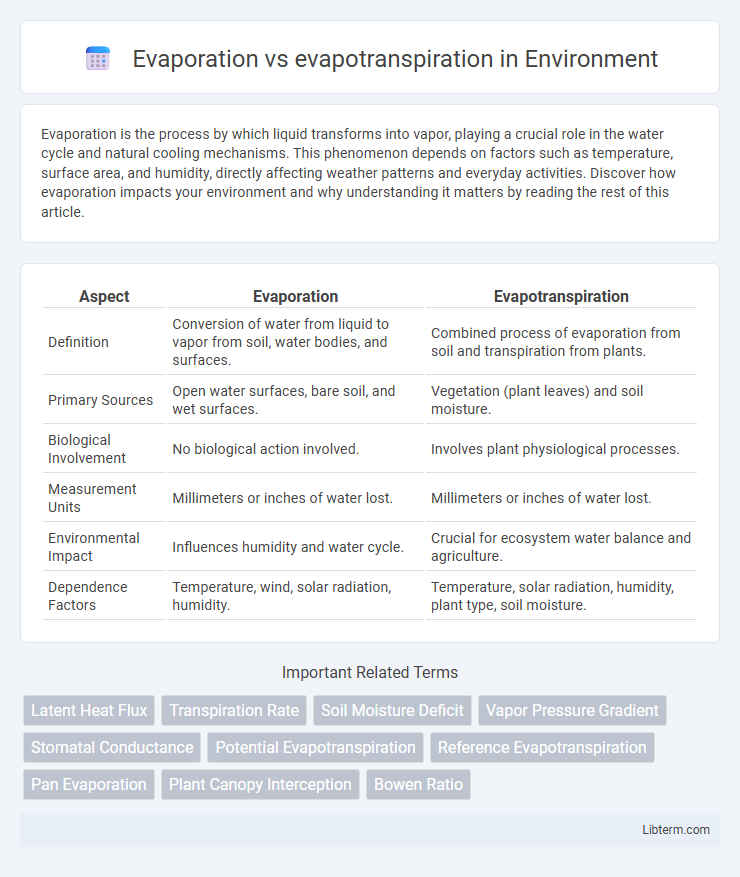Evaporation is the process by which liquid transforms into vapor, playing a crucial role in the water cycle and natural cooling mechanisms. This phenomenon depends on factors such as temperature, surface area, and humidity, directly affecting weather patterns and everyday activities. Discover how evaporation impacts your environment and why understanding it matters by reading the rest of this article.
Table of Comparison
| Aspect | Evaporation | Evapotranspiration |
|---|---|---|
| Definition | Conversion of water from liquid to vapor from soil, water bodies, and surfaces. | Combined process of evaporation from soil and transpiration from plants. |
| Primary Sources | Open water surfaces, bare soil, and wet surfaces. | Vegetation (plant leaves) and soil moisture. |
| Biological Involvement | No biological action involved. | Involves plant physiological processes. |
| Measurement Units | Millimeters or inches of water lost. | Millimeters or inches of water lost. |
| Environmental Impact | Influences humidity and water cycle. | Crucial for ecosystem water balance and agriculture. |
| Dependence Factors | Temperature, wind, solar radiation, humidity. | Temperature, solar radiation, humidity, plant type, soil moisture. |
Understanding Evaporation: Definition and Process
Evaporation is the process by which water changes from a liquid to a vapor state due to heat energy from the sun, occurring primarily on open water surfaces, soil, and plant leaves. This process is influenced by factors such as temperature, humidity, wind speed, and surface area, which determine the rate at which water molecules escape into the atmosphere. Understanding evaporation is essential for distinguishing it from evapotranspiration, which combines evaporation with transpiration from plants, providing a more comprehensive measure of water loss in ecosystems.
What is Evapotranspiration? Key Concepts Explained
Evapotranspiration is the combined process of water evaporation from soil and plant surfaces and transpiration through plant stomata, representing a crucial component of the water cycle. It quantifies the total water loss from land to the atmosphere, integrating meteorological factors like temperature, humidity, solar radiation, and wind speed with vegetation characteristics. Accurate measurement of evapotranspiration supports agricultural irrigation management, hydrological modeling, and climate studies by providing insights into water availability and ecosystem health.
The Science Behind Evaporation and Evapotranspiration
Evaporation involves the physical process where water changes from liquid to vapor due to solar energy, primarily occurring from surfaces like soil and water bodies. Evapotranspiration combines evaporation with transpiration from plants, reflecting the total water vapor flux to the atmosphere in terrestrial ecosystems. This process is driven by factors such as solar radiation, air temperature, humidity, and vegetation characteristics, playing a critical role in the hydrological cycle and water balance studies.
Major Differences Between Evaporation and Evapotranspiration
Evaporation is the process where water changes from liquid to vapor form, primarily occurring on surfaces such as soil, water bodies, and plant leaves, driven by solar energy and atmospheric conditions. Evapotranspiration combines evaporation and transpiration, representing the total water vapor flux from both soil and plant foliage, making it a critical component in the hydrological cycle and agricultural water management. Major differences include the involvement of plant physiological processes in evapotranspiration versus evaporation being a purely physical process, and the scope of measurement where evapotranspiration accounts for both soil evaporation and plant transpiration, reflecting actual water use by vegetation.
Environmental Factors Influencing Evaporation
Environmental factors influencing evaporation include temperature, solar radiation, humidity, wind speed, and soil moisture. Higher temperatures and increased solar radiation accelerate the evaporation rate by providing more energy for water molecules to transition from liquid to vapor. Low humidity, strong winds, and abundant soil moisture further enhance evaporation by increasing the vapor pressure gradient and facilitating water vapor removal from surfaces.
Environmental Factors Shaping Evapotranspiration Rates
Evapotranspiration rates are strongly influenced by environmental factors such as temperature, humidity, wind speed, and solar radiation, which together regulate water vapor flux from soil and vegetation surfaces. Vegetation characteristics, including leaf area index and stomatal conductance, modulate the transpiration component of evapotranspiration. Soil moisture availability also plays a critical role by controlling the evaporation potential and plant water uptake, thus shaping the spatial and temporal variability of evapotranspiration within ecosystems.
Importance of Evaporation in the Water Cycle
Evaporation plays a crucial role in the water cycle by converting liquid water from surfaces like oceans, lakes, and soil into water vapor, facilitating atmospheric moisture transport. This process regulates temperature, supports cloud formation, and drives precipitation patterns essential for sustaining ecosystems and agriculture. Evaporation's impact on global water distribution significantly influences weather systems and climate dynamics.
Significance of Evapotranspiration in Ecosystems
Evapotranspiration represents the combined process of water evaporation from soil and transpiration from plants, playing a crucial role in maintaining ecosystem water balance and regulating microclimates. This process supports plant growth by facilitating nutrient uptake and cooling through water vapor release, directly impacting agricultural productivity and natural vegetation health. Ecosystem resilience against drought is enhanced by evapotranspiration, as it modulates soil moisture and contributes to the hydrological cycle's stability.
Measuring Evaporation vs. Measuring Evapotranspiration
Measuring evaporation primarily involves quantifying water loss from open water surfaces or soil using evaporimeters, atmometers, or lysimeters, which capture direct water vapor flux. Evapotranspiration measurement combines evaporation and plant transpiration processes, typically assessed through methods such as eddy covariance systems, lysimeters, soil moisture sensors, and remote sensing models like the Penman-Monteith equation. Accurate differentiation between evaporation and evapotranspiration enables precise water resource management and irrigation scheduling in agriculture and hydrology.
Real-World Applications: Evaporation and Evapotranspiration in Agriculture
Evaporation and evapotranspiration critically influence water management in agriculture by determining soil moisture levels and crop water requirements. Precise measurement of evapotranspiration, which combines evaporation and plant transpiration, enables optimized irrigation scheduling, reducing water waste and enhancing crop yields. Advanced tools like remote sensing and soil moisture sensors assist farmers in monitoring these processes for sustainable agricultural practices and improved resource efficiency.
Evaporation Infographic

 libterm.com
libterm.com